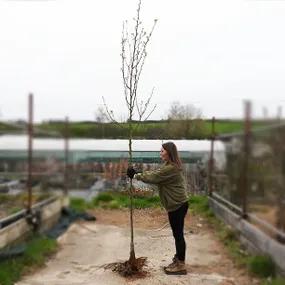Callery Pear, Large Trees
The details
- Excellent roadside foliage tree.
- Any soil with decent drainage.
- Max Height 10m
- Easy to shape
- Bareroot Delivery: Nov-Mar
Description
Pyrus calleryana Chanticleer: Bareroot Callery Pear Trees in Standard Sizes
Pyrus calleryana Chanticleer, the Callery Pear, is an ornamental, flowering specimen with a long season of interest and leaf cover. The glossy, bright green foliage appears very early in the season (often the first) and still looks fresh in autumn. When the leaves finally turn, their autumn colouring is magnificent: a purple-red that can shift to crimson or orange-yellow, depending on the soil, lasting into December in most years. All of which makes it an outstanding subject to use for screening, avenue and roadside planting or as a structural statement.
It is covered in clusters of creamy white blossom in early spring that are a good source of nectar for bees when it is in short supply. The fruit is inedible, inconspicuous and is usually eaten by wildlife.
They vigorously reach a height of 10-12 metres.
You can buy eating pear trees, as well as weeping ornamental pears.
Browse our full range of trees.
Delivery season: Pear trees are delivered bareroot during late autumn and winter, approximately November-March inclusive.
Choosing a size: Small trees are cheaper, easier to handle and more forgiving of less than ideal aftercare, so they are best for a big planting project. If instant impact is your priority, or if you are only buying a few plants for use in a place where it is convenient to water them well in their first year, then you may as well use bigger ones. All our bareroot trees are measured by their height in centimetres above the ground (the roots aren't measured).
Features:
- Superb foliage tree, good for screening.
- White flowers in April-May are good for bees.
- Full sun is best, partial shade is fine.
- Any reasonably well drained soil.
- Pollution & paving tolerant, good for roadsides.
- To 10-12m
- Bareroot Delivery Only Nov-March
Growing Callery Pears
They will look best in full sun, partial shade is fine for their Autumn colour as long as they get all the midday sun. They aren't fussy about soil, mildly acidic to chalk is fine, and like heavy clay on well drained areas. They won't be happy right on the coast in sand, but tolerate salty winds well.
If there is heavy snow, gently brush it off with an upwards motion to keep the branches safe from breaking.
Planting Instructions
Notes on planting Pyrus calleryana Chanticleer trees:
These hardy trees aren't at all fussy - as long as the soil has good drainage, they will grow well in even the worst soil types, including compacted earth next to a road. They don't mind partial shade, though they will flower best in full sun.
They are so compact that it is hard to imagine that you will ever need to cut them back but if you do, wait until all the leaves have fallen.
Prepare your site before planting:
It is good to dig over the site where you plant a tree several months in advance. Kill the weeds first: for tough weeds like nettles, brambles and ground elder, you will usually need a weed-killer to get rid of them. When you dig the soil over, remove stones and other rubbish and mix in well rotted compost or manure down to the depth of about 2 spades.
Watch our video on how to plant a tree for full instructions.
Remember to water establishing trees during dry weather for at least a year after planting.
Tree Planting accessories:
Prepare your site for planting by killing the weeds and grass.
You can buy a tree planting pack with a wooden stake & rubber tie to support the tree and a mulch mat with pegs to protect the soil around the base of your tree from weeds and drying out.
We suggest that you use mycorrhizal "friendly fungi" on the roots of all newly planted large trees: if your soil quality is poor, we strongly recommend it.
You can also improve your soil with bonemeal organic fertiliser.
Did You Know?
It was bred in 1956 in the USA by Edward Scanlon, who used parent trees that were brought from China in the early 1900s by the famous collector Ernest Wilson. The wild tree was first described in 1872 by a French missionary to China, Joseph Callery.
Chanticleer is the name of a cockerel who appears in several medieval stories, including The Nun's Priest's Tale in The Canterbury Tales. It means "sing clearly" in old-ish French.
This tree has a lot of critics in hot areas of America, where the climate reduces its attractive shelf life, causing it to start cracking apart after around thirty-forty years. This is not an issue anywhere in the UK.
It was awarded an RHS Award of Garden Merit in 2002, but lost it in a later, probably in favour of newer cultivars.
Standard trees are measured by their girth in centimetres 1 metre above ground level: their trunk's waist measurement. Unlike sapling trees and hedge plants, standards aren't measured by their height, which will vary quite a bit both between and within species.
So, a 6/8cm standard tree has a trunk with a circumference of 6-8cm and an 8/10 standard has a trunk 8-10cm around. This measurement makes no difference to the tree's final height.
On average, standard trees are 2-3.5 metres tall when they arrive, but we cannot tell you precisely how tall your trees will be before we deliver them.

 1.webp)
 1.webp)
 2.webp)
 3.webp)
 4.webp)
